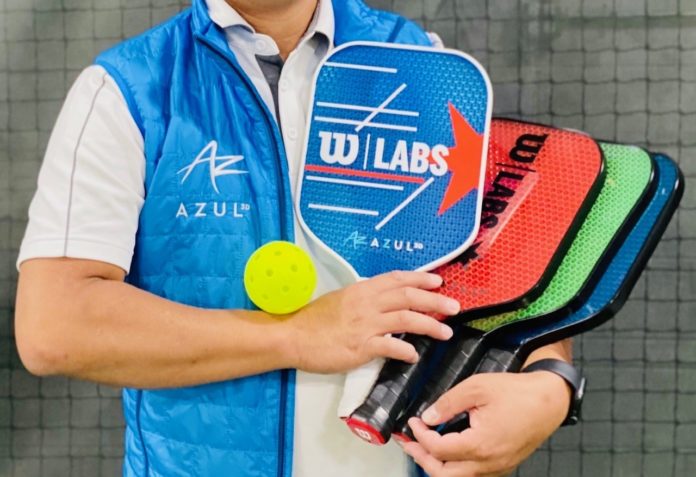Pickleball (sometimes spelled Pickle-Ball) is a paddleball sport (similar to a racket sport) that combines elements of badminton, table tennis, and tennis. Instead of rackets, players use paddles that should provide them with extra power, control, and feel. They are often manufactured with heavy industrial equipment, similar to that used to manufacture tennis and badminton racquets.
With the goal of exploring how Additive Manufacturing could enhance the production process of this equipment, 3D printing company Azul 3D has recently partnered with OEM Wilson Sporting Goods to create two new 3D-printed pickleball paddle designs that will improve the game of players in this sport.
If you are not familiar with Azul 3D, note that the 3D printing company develops a proprietary high area rapid printing (HARPTM) technology which is another version of stereolithographic printing. It converts liquid plastic into solid objects using ultraviolet light and can print vertically at high speeds and over vastly larger print areas than current commercial 3D printers. The process is said to lower the upfront and sustained costs in the manufacturing of goods. During its latest funding round, Chad Mirkin, Azul 3D cofounder and chair said the company wanted to secure major partnerships in order to validate this point in the very near future.
This collaboration is the first one the company publicly announced since that funding round. With Azul 3D’s 3D printing, not only the paddles can be customized to each player – the Core paddle actually -, but they are also very quiet. They reduce the sound from ball hits, which solves a major problem in this sport.
The paddles have been 3D printed on the company’s flagship product, the LAKE 3D printer. The collaboration between Azul 3D and Wilson reveal that the 3D printed paddle’s new design is made of a true 3D lattice that is specifically designed to remove the frequencies that cause many hits to resonate throughout the court area, compared to 2D honeycomb cores designed for the aerospace industry. Not only can these lattices be printed in different shapes and densities but the design shifts can reduce dead spots or increase the punch in certain areas of the paddle.
“Pickleball is one of the fastest growing sports in America,” said Bob Thurman, VP of Wilson Labs at Wilson Sporting Goods. “We were excited to work with Azul 3D to create a better paddle and better pickleball experience for our customers. We look forward to bringing this paddle to market.”
The manufacturer explains that this collaboration also represents a true local partnership – as both companies are based in Chicago. Because the entire paddle is printed with HARP technology, it reduces the parts needed from five to one, eliminating supply chain issues that have plagued manufacturing throughout the COVID-19 pandemic.
That being said, our analysis of the use of AM technologies within the sports industry reveals that Pickleball is the 15th sport discipline that can make use of AM. However, it should be noted that despite its popularity in North America and in Europe, Pickelball is not an official Olympic sport. To become one, it needs to be recognized by the International Olympic Committee and the main criteria is that it has to be played in 75 countries across four continents for men’s competition or 40 countries on three continents for women’s competition.
In the 2021 May/June issue of 3D ADEPT Mag, the “applications” segment (PP 45-50) discusses sport applications made possible using AM technologies.
Remember, you can post job opportunities in the AM Industry on 3D ADEPT Media free of charge or look for a job via our job board. Make sure to follow us on our social networks and subscribe to our weekly newsletter : Facebook, Twitter, LinkedIn & Instagram ! If you want to be featured in the next issue of our digital magazine or if you hear a story that needs to be heard, make sure you send it to contact@3dadept.com






